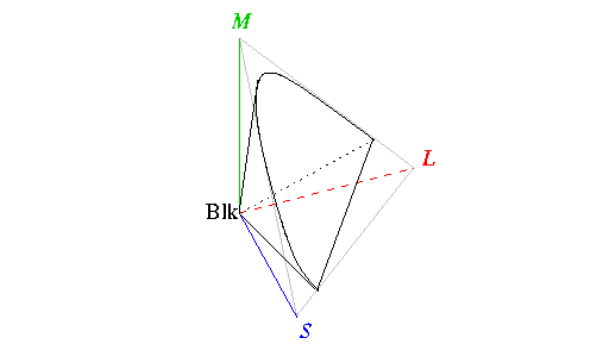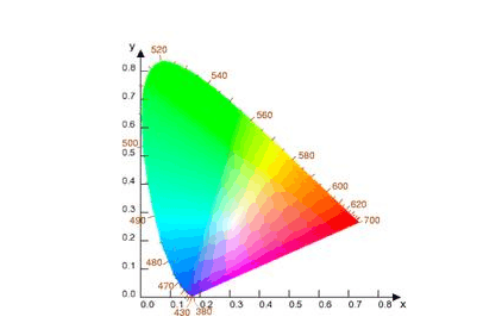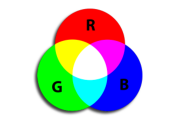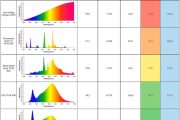Spectrum of visible light
| Color | Wavelength | Frequency |
| Red | About 625~740 nm | About 480~415 MHz |
| Orange | About 590~625 nm | About 510~480 MHz |
| Yellow | About 565~570 nm | About 530~510 MHz |
| Green | About 500~565 nm | About 600~530 MHz |
| Cyan | About 485~500 nm | About 620~600 MHz |
| Blue | About 440~485 nm | About 680~620 MHz |
| Purple | About 380~440 nm | About 790~680 MHz |
The wavelength and intensity of electromagnetic wave can be very different. In the wavelength range that people can feel (about 380 nm to 740 nm), it is called visible light, sometimes referred to as light. If we list the intensities of various wavelengths of a light source together, we can obtain the spectrum of the light source.
The spectrum of an object determines its optical properties, including its color. Different spectra can be received as the same color. Although we can define a color as the sum of all these spectra, different animals see different colors, and different people feel different colors, so this definition is relative subjective.
A surface that diffusely reflects all wavelengths of light is white, while a surface that absorbs all wavelengths of light is black.
Each color of a rainbow contains only one wavelength of light. We call this color monochromatic. The spectrum of a rainbow is actually continuous, but it is generally divided into seven colors: red, orange, yellow, green, green, blue and purple, but each person’s classification is always slightly different. The intensity of monochromatic light will also affect people’s perception of the color of a wavelength of light, such as dark orange is felt as brown by people, and dark yellow green is perceived as olive green, and so on.
The display does not produce a monochromatic orange. Because of the physiological principle of the eye, we can’t distinguish the colors of these two kinds of light.
There are also many colors that cannot be monochromatic, because there is no such monochromatic color. Black, gray and white, for example, are all these kind of colors, so is pink or purplish.
Wave equation is used to describe the light equation, so we should be able to get the color information by solving the wave equation. In vacuum the wave equation of light in space is as follows:
Utt = c2(uxx + uyy + uzz)
Here, C is the speed of light, x, y and Z are the coordinates of space, t is the coordinates of time, u (x, y, z) is the function describing light, and the subscript means partial derivative. At a fixed point in space (x, y, Z fixed), u becomes a function of time.
Through Fourier transform we can obtain the amplitude of each wavelength. From this we can get the intensity of this light at each wavelength. In this way, we can obtain a spectrum from the wave equation.
But in fact, to describe what color a group of spectra will produce, we need to understand the physiological function of the retina.
Aristotle had already discussed the relationship between light and color, but it was Isaac Newton who really clarified the relationship. John Wolfgang Goethe has also studied the causes of color. Thomas Young first put forward the theory of tricolor in 1801, and later Herman von Helmholtz perfected it. In the 1960s, people discovered the pigment that can sense the color inside the human eye, so the correctness of this theory has been approved.
Cone cells and rod cells in human eyes can sense color. Generally, there are three kinds of cone cells in human eyes: the first one mainly feels red, and its most sensitive point is about 565 nm; The second one mainly feels green, and its most sensitive point is about 535 nm; The third one mainly feels blue, and its most sensitive point is about 445 nm. There is only one type of rod-shaped cell, and its most sensitive color wavelength is between blue and green.
The sensitivity curve of each type of cone cell is approximately bell shaped. Therefore, the light entering the eye generally corresponds to these three types of cones and rods dendritic cells were divided into four different intensity signals.
Because each cell also reflects other wavelengths, not all spectra can be distinguished. For example, green light can not only be accepted by green cones, but also other cones can produce certain intensity signals. The combination of all these signals is the sum of colors that can be distinguished by the human eye.
If our eyes look at a color for a long time, we will turn our eyes away and see the complementary color of this color in other places. This is called the complementary principle of color. In short, when a cell is stimulated by light of a certain color, it will release two signals light at the same time: stimulating yellow, and at the same time making yellow complementary color purple.
In fact, the signal produced by the light in the retina of a scene is not 100% equal to the feeling of people. The human brain processes these signals and analyzes and compares the surrounding signals. For example, a picture of the White House with a green filter – the image of the White House is actually green. But because of the inherent impression of the human brain on the White House and the green hue of the surrounding environment, the human brain will remove the green barrier – often still feel the White House as white.
The human eye can distinguish about 10 million colors, but this is only an estimate. Because the structure of each eye is different, and each person sees a little different colors, the distinction between colors is quite subjective. If one or more of a person’s cone-shaped cells can not normally reflect the incident light, then the person can distinguish less colors. Such a person is called achromatic. yes This is also called color blindness, but in fact it is not correct, because there are very few people who can only distinguish between black and white.
Rod like cells. Although rod-shaped cells are generally considered to be able to distinguish black and white, their sensitivity to different colors is slightly different, so when the light is dark, the photosensitive properties of rod-shaped cells become more and more important.
Some animals, such as most other mammals, have fewer types of color sensing cells than humans. Some animals can feel colors that are invisible to people, such as bees, can feel ultraviolet light.
If we use the X, y and Z axes in Euclidean space to represent the intensity of the most sensitive wavelengths of human cone cells, then we can obtain a three-dimensional color space. The origin of this space is black. The farther away from the origin, the stronger the light. White has no fixed points in this space. According to the color temperature and the surrounding light, we may regard different points in this picture as white.
The color one can feel in this picture is a cone with a horse kick at the bottom. Theoretically, the cone has no stopping point, but too much light can damage the eyes. In the case of low light intensity, people’s perception of color will change, but generally speaking, people are sensitive to the part depicted by the black line on the right.
To be precise, there are no colors like brown or gray in this image. These colors are actually orange and white that are darker than the surrounding colors. We can easily prove this point: when we look at the image of a projector projected on a piece of white cloth, we will see the black words projected on the white cloth, but in fact, the color of these black words is the same as that of the white cloth when it has not been projected. After projection the white cloth around these black words is illuminated, so we feel that they are relatively black.
People can’t see pure red, green or blue because our cones respond to other colors. When we look at pure blue, our red and green cones produce signals, too, it’s like a mixture of red and green in blue.
Different spectra can produce the same color sense in the human eye. For example, the white light of a fluorescent lamp is composed of several rather narrow spectral lines, while the sunlight is composed of continuous spectra. In terms of light, the human eye cannot distinguish the two. Only when they reflect on objects of different colors, we can see that one is the light of fluorescent lamp and the other is the sunlight.
In most cases, people can see the color can be made of meta color. This is used in photos, printing, television, etc to reflect the color.
In spite of this, the matching color is often not exactly the same as the pure monochrome, especially in the middle of the visible spectrum, the matching color can only be very close to the monochromatic light, but can not fully achieve its effect. For example, green light (530 nm) and blue light (460 nm) can be combined to produce blue light. But this blue light always makes people feel not very pure. This is because human red cones can also sense green and blue, and their response to the matching color is better than that of pure cyan (485 nm), so we will feel the color with a little “red”, a little impure.
In addition, the primary colors used in technology are not pure, so generally speaking, they can not completely show pure monochromatic light. However, there are few pure monochromatic light in nature, so generally speaking, the color composed of primary colors can reflect the original color very well. The sum of colors that a technical system can produce is called gamut.
Errors can also occur when recording colors through a camera or scanner. Generally, the photosensitive characteristics of the photosensitive elements in these instruments are quite different from those of human eyes. Therefore, under special illumination, the color produced by these instruments may be big different from the impact that felt by human eyes.
Light emitting media (such as TV sets) use red, green, and blue tricolors, and each light stimulates only the cones that target them, as far as possible, without stimulating other cones. The gamut of this system accounts for most of the color space that people can feel, so TV and computer screen use this system.
In theory, we can also use other colors as meta colors, but we can maximize the human color space by using red, green and blue. Unfortunately, there is no fixed wavelength definition for red, green and blue, so different technical instruments may use different wavelengths to create a slightly different color on the screen.
We can get a larger color gamut by painting cyan, magenta and yellow transparent pigments on the white background. These three colors are subtractive tricolor. Sometimes we add black to produce a darker color.
Diffraction, a certain color of light will be reflected to a certain angle. The surface of this object will produce a special rainbow like flash. Peacock feathers, many butterfly wings, Fritillaria, etc. will produce such structural colors. Recently, some car manufacturers have also use special paint to achieve this fluorescent effect.








